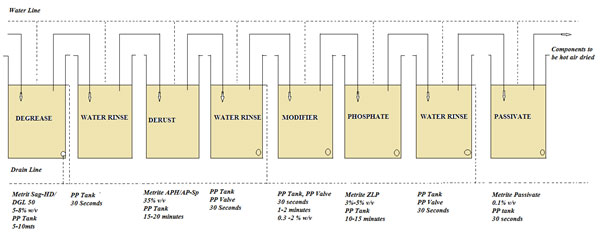Zinc phosphating is also well know as 7 tank process.
A high-quality conversion coating is essential for the durability of painted metal goods. The process of applying an inorganic conversion coating(phosphate) to a metallic surface involves removing any surface contaminants, then chemically converting the clean surface into a non-conductive, inorganic conversion coating. Conversion coatings increase the overall surface area and promote adhesion of the subsequently applied paint. In addition, conversion coatings change the chemical nature of the surface(It Forms zinc phosphate or iron phosphate) which increases corrosion resistance. It is these two functions, increasing surface area and changing the surface chemistry, that serve as a base for preparing the substrate material for paint finishes.
The process of Phosphating basically relies on the basic pickling reaction that will occur on the metal substrate if the process solution will come in contact with metal. The biggest benefit that Phosphating can give is corrosion protection and strong adhesion. Just like Phosphate Coating, the process of Phosphating is being used for steel parts.
HOW IS PHOSPHATING USED
- Cleaning
To increase the effectiveness of the finish, parts must be clean prior to coating. Aqueous cleaning(water based), vapor degreasing or ultrasonic cleaning are typical cleaning processes, and of the three, aqueous cleaning makes up the majority.
Aqueous cleaners are Alkaline degreasers.
- Rust Removal
Acids are generally used for rust removal. Rust is removed by phosphoric based acids and scale is generally removed by mixed acids which have hydrochloric, phosphoric and sulphuric, and in varying degrees.
- Surface Activation
- Surface conditioning rinses are used in zinc phosphating to refine crystal size and control coating weight. State-of-the-art conditioners are liquid products that can be consistently applied using metering pumps.
- The surface conditioning rinse takes place just before the zinc phosphate stage and is the only step in the process that is followed by another chemical stage, the zinc phosphate bath.
- Phosphating
Traditionally, the choices for a pretreatment process have been either an iron or zinc phosphate which provided the degree of performance necessary for the operation.Zinc phosphating is used for material which requires high salt spray hours.



